In writing this article, I’m remembering the value of Substack a lot! Talking about new subway rolling stock is super important, because the rolling stock is the biggest interface between the over one million people per day who ride the subway in Toronto every day, but it’s also the type of thing that kills YouTube channels. At the same time, rolling stock is a fairly discrete element from other components of the transit system — you can basically buy the most modern trains even if your stations and other infrastructure is old and has issues.
Of course, this has never stopped many transit agencies in North America from ordering shamefully dated rolling stock. (Denver ordered 90s designed light rail sets as recently as 2015, a likely for economies of scale, but still…) Meanwhile in the US, I still don’t believe a single system has even adopted open-gangway metro trains (though a few have now ordered them), and for what it’s worth, the big three Canadian metro systems all have purchased open-gangway metro trains. Anyways, back on topic — Toronto is ordering new trains! These are meant both for replacing the T1 rolling stock used on Line 2 from the 1990s and serving additional demand from higher frequency on Line 1, as well as two fairly major subway extension projects — so a lot will be needed!
So, what is Toronto getting?
Well, the TTC just recently released a 1000+ page RFP for the new trains. I started reading it on vacation, but it’s been on the back burner while I’ve been getting caught back up. We can start to predict given they’ve (pretty typically for the TTC) presented really highly-prescriptive requirements, which should make it very clear what we are getting from one of the four prequalified manufacturers: Alstom, Hyundai, Kawasaki, and CRRC. Out of these four, I’d guess it’s quite unlikely that CRRC wins given the international relationship context, but they also have a really bad reputation for quality in North America; I have no strong preference between the rest and all have built good rolling stock in North America (Some might mention Hyundai’s poor reputation in the United States, but their trains on the Canada Line have been fine and highly prescriptive requirements will probably help).
Overall, I think the new trains are a step in the right direction on almost every point, but I do think they are missing things, and that’s always a problem with transit vehicles (and especially rail vehicles) that will likely be in use for nearly forty years!
The whole set of requirements is quite interesting, but in my eyes predictable given the context of the TTC — the agency needs trains which can use the Greenwood yard on Line 2, which isn’t designed for long, fixed-consist trains, and at the same time is likely looking to standardize trains fleet wide for economies of scale (this also provides the benefit of making things like platform screen doors more practical in the future).
Given this, everything really starts at the formation level.
The specification calls for trains that can be combined into six-car, walk-through sets, as are currently used on Line 1, but could also be configured into other consists that would work on Line 4 (4 cars) and more on the fly. This comes from a bin-of-parts approach, where there are cab cars as well as other intermediate car types that can be decoupled, despite having proper gangways to allow passengers to walk through them (something which other cities HAVE done). That being said, cars will remain in married pairs as is typical.
My guess is the gangways will be less wide open and nice than Line 1, based on experience with trains that have this capability in other cities, but I would love to be pleasantly surprised, and the gangways will surely be better than what exists between, say, Line 2 cars right now (i.e. non-existent)! Because cars will come in married pairs, it’s likely that every other gangway (i.e those between sets of married pairs) is at least slightly different, as there presumably needs to be the capability to operate the individual married pair from here — mostly for yard operations.
It’s exciting that the TTC is pushing for open gangways despite also having the capability to split trains up — it feels very counter to what I would typically expect in North America, which would be something like “operational considerations should come before passenger comfort and convenience!” (and counter to what many have told me is *possible* even if other places do it…)
Even better, the trains are meant to be able to accommodate a short ~15m seventh car, which would allow them to occupy the full length on platforms on the system. Given the endless articles and statements about how Line 1 needs more capacity, it’s always amazed me that this wasn’t done decades ago, but it’s good to see the door being left open to it. Since the trains are being ordered in flexible sets, it seems conceivable that such short middle cars could be ordered a few years after delivery of the rest if desired. There are of course other considerations here too, with longer trains requiring more power and pocket/storage tracks.
Aesthetics are another place where the new trains (which the documents refer to as the “NST” or “New Subway Train”, but given the appearance are likely to be referred to as “TR2” or “Toronto Rocket 2” at least informally) are a fairly big change. The front fascia of the trains cabs has a similar curved shape to the Toronto Rocket, albeit with lots of glossy red to replace some of the current glossy black that actually continues along the upper sides of the train. It’s also got more modern looking LED headlight arrays, and a white LED destination sign (although of course it’s possible that some of these end up changing!). The doors on the train (still four per side) are also coloured red, but far more of them is taken up by a much larger, full-height window, akin to the Flexity Streetcars or metro trains in cities like Berlin. They also at least appear to be a little wider than the current doors. I’m really happy about all of this: The tin-can look of a lot of rolling stock is, in my eyes, an objectively bad thing, and adding more visual intrigue is good. That being said, trains could look better or worse than expected depending on how they are built (and who builds them), so I will reserve final judgement until we can see a real model!
Now, while I like the aesthetics overall, I think more could clearly have been done for capacity. These trains are mostly going to be used on Line 2, which is less used (though a decent number will operate one Line 1), but that doesn’t mean they still couldn’t be more open. The layout as planned seems to be very similar to the Toronto Rocket, albeit potentially with vertical poles in the centre of the car at the middle two doors. I’m of two minds about this: Vertical poles seem good, but people tend to park at them, and this not only makes it harder to get into a car or further in when it’s busy, but it also makes walking down the train to get to the right end of a platform harder.
If I can critique at all, it’s that I would have preferred an Elizabeth Line-style approach to the trains. We could still have some transverse seats, but they should be enhanced with armrests and high backs, and oriented around passengers who need to travel long distances along a line, and I would probably change the mix from today which is about 55-45 longitudinal-to-transverse to about 70-30 or 75-25. I also appreciate that most longitudinal seats in London have armrests, allowing you to lean and stabilize yourself (it’s much more comfortable), and most longitudinal seats on Japanese trains seem to have overhead luggage racks that utilize the wasted vertical space, and make it so that if you’re travelling with, say, a backpack (which many people do!) you can put it over you or another passenger, freeing up space and making riding more comfortable!
With regard to internal signage, while we don’t appear to be moving to a 95% digital screen model like some systems — there appear to be plans to move to around 50% digital advertising screens (probably not just for advertising). But fortunately, provision is made to move to 100%, and other screens will likely also be featured, for example facing down the length of the train as in many Siemens trains, and perhaps in the locations where poster-style maps and ads are currently placed. The LED line display also sounds like it will be replaced with something more flexible that will be able to provide more relevant information to the current line passengers are on. All of this is great (and I mean it, it’s basically a meme at this point that I love LCD wayfinding), though LCD screens are even more dependent on the wayfinding and implementation quality than LED dot screens, so it’s possible we have great screens with ugly or not helpful graphics — I hope not!
Other modern features were also referenced in the RFP, including wifi and USB provision, which, given the cell coverage in portions of subway tunnels (and well anywhere above ground) could enable useful open wifi access as well as charging. I don’t spend a lot of time advocating for this, but it’s honesty great — wifi especially is something I used on trains across the TFL network and it’s even more relevant in Canada with our horrendously overpriced cell carriers.
Another feature that is mentioned is heated floors. If I recall correctly, these are used on Calgary’s newest LRVs and potentially also the REM trains and could be beneficial if only for freeing up space around the transverse seats from heaters. That being said, other places like Korea even have subway cars with heated seats, so this doesn’t feel cutting edge.
Signalling is an interesting question for these new trains given the mixed nature of the current system, between the now complete CBTC/ATC system on Line 1 and more traditional signalling on Line 2. The TTC wants to acquire signalling equipment separately and is also interested in dual CBTC fitment. In some places, this is starting to be used to implement two parallel signalling systems for reliability and extra protection and resiliency, but in Toronto’s case it seems this is probably to accommodate for a different vendor being chosen to provide CBTC for Line 2 when its impending upgrade comes around — which would be incredibly foolish!
There is also mention of provision for driverless operation, though as far as I know this would not be used to actually run every train without a driver. Instead, this would be used for similar purposes to the Elizabeth line trains which have a (still potentially not fully ready for service?) functionality called auto-reversing, which allows the train to turn itself around at a terminal, allowing the single operator to walk along the platform to the other cab. This would be augmented by other new safety features, including some form of sensor (be it ultrasonic, laser, radar, etc) that would be used to detect people or debris in front of the train, as well as a different sensor that could be used to detect which side of the train a platform is on to prevent accidental opening of doors on the wrong side, or potentially between stations (which has happened unfortunately).
Overall, despite being derivative of the Toronto Rockets in many ways, these new subway trains seem quite substantially improved, and if I’m honest, I’m quite excited for them. While the design isn’t quite as attractive as it could be, they should have it where it counts — and that’s something we should never take for granted!




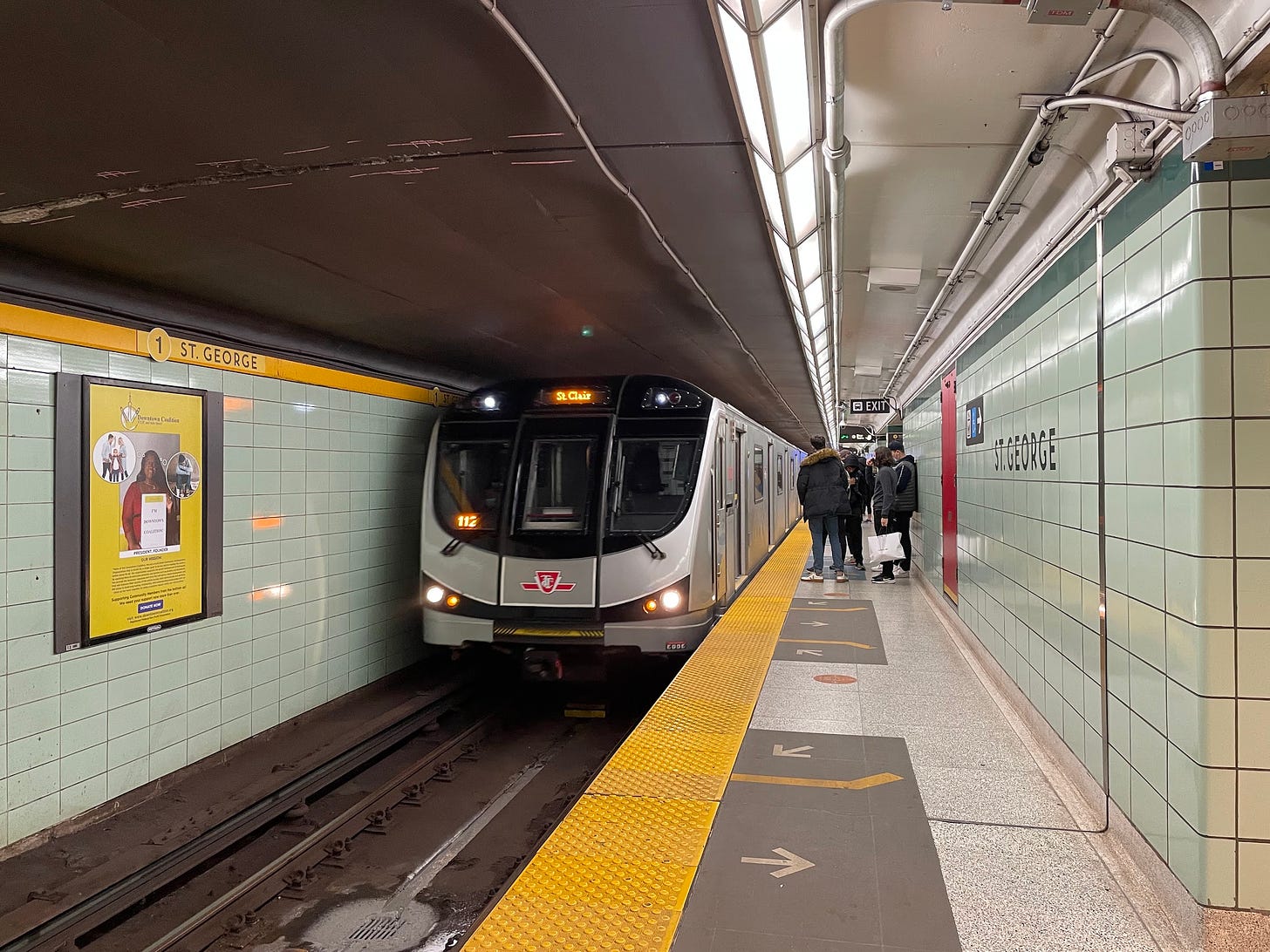

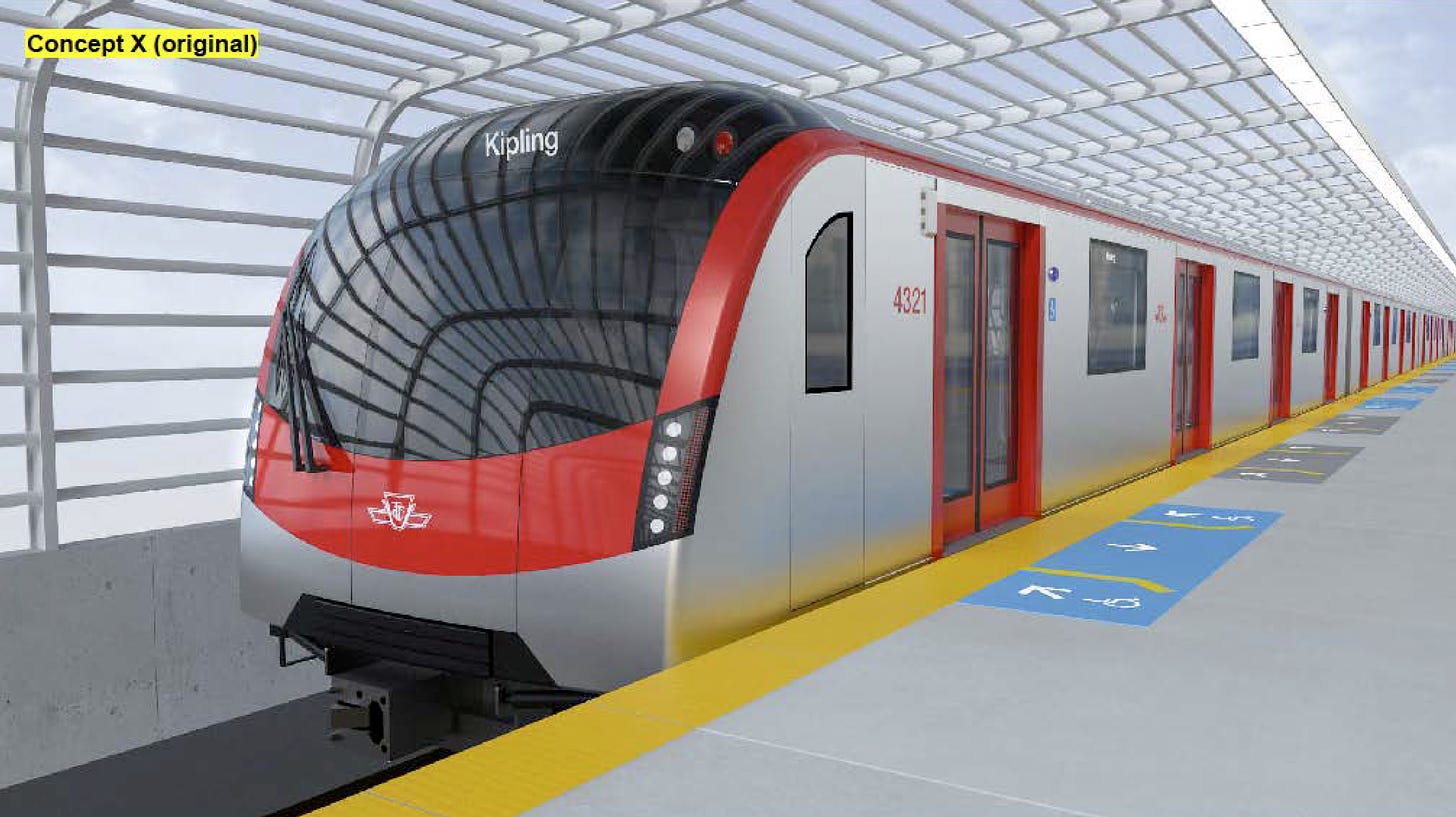
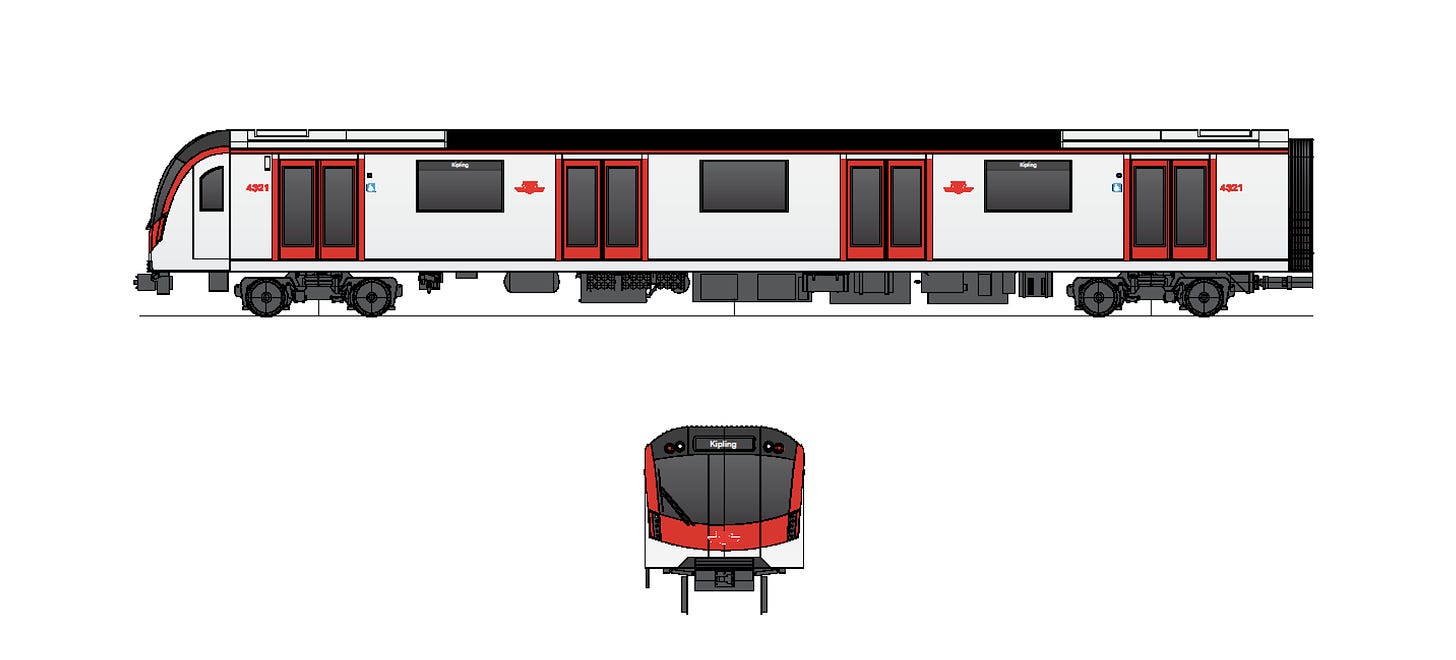
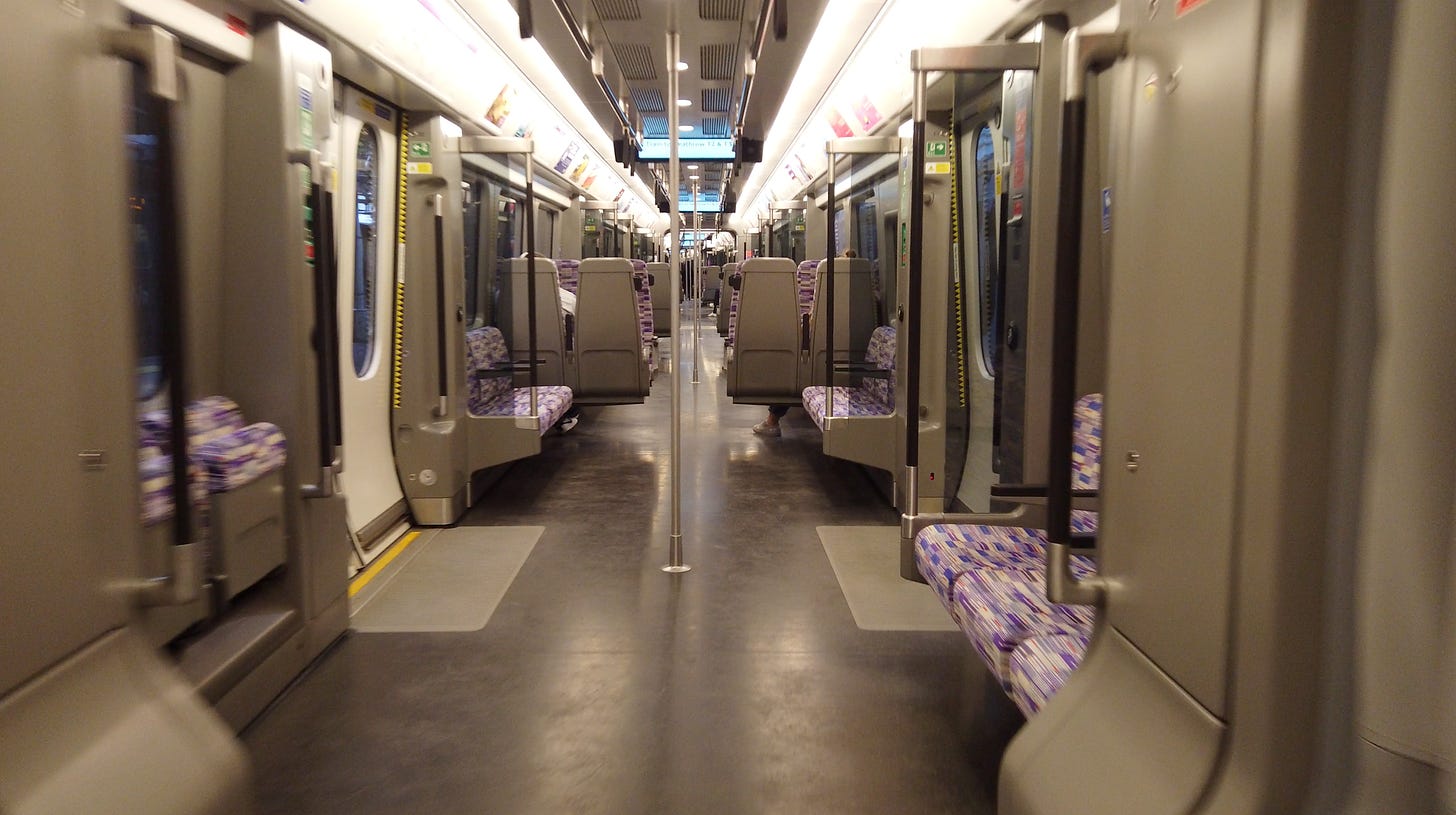
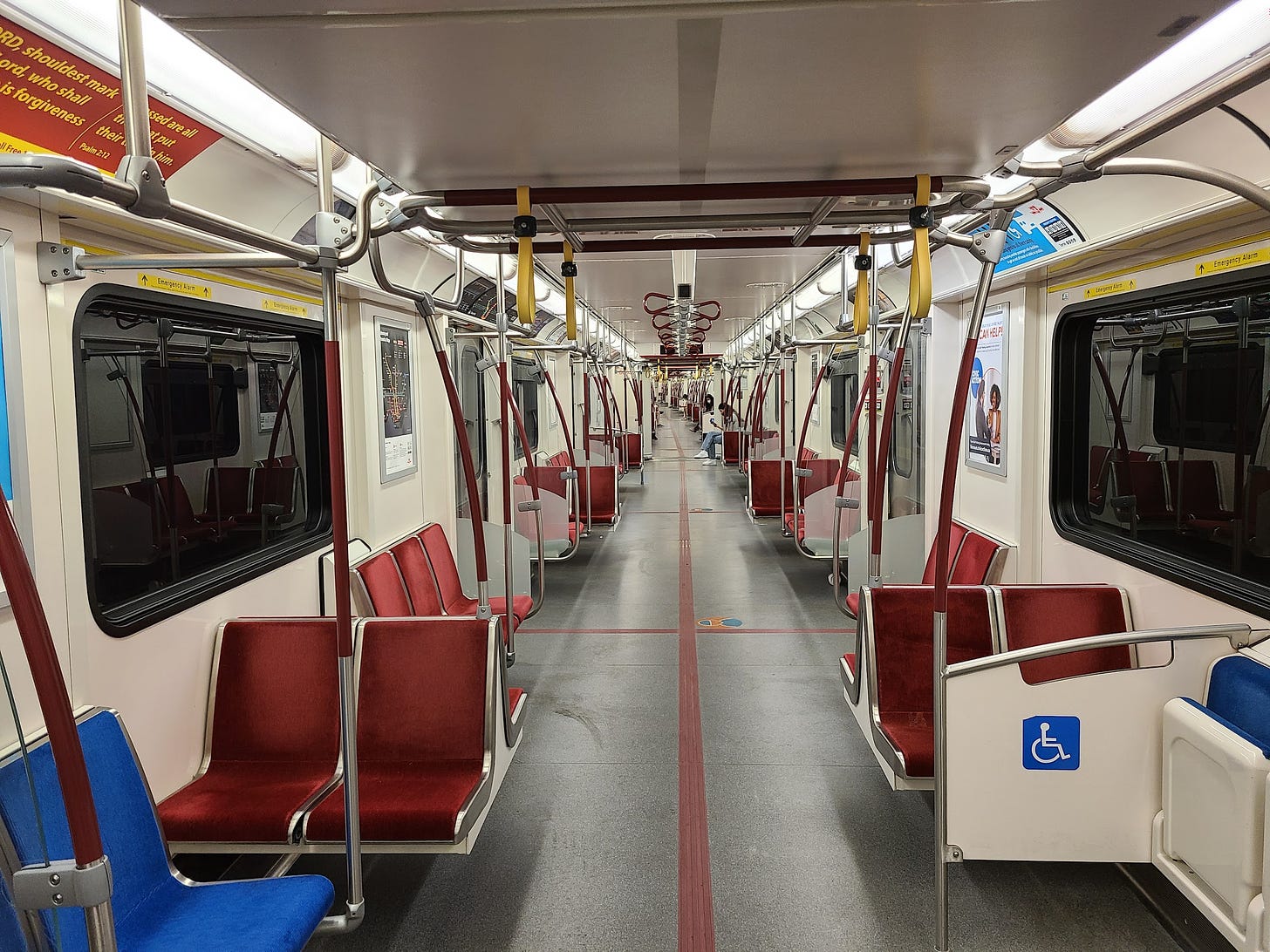
Hi Reece
Thanks for the review of the specs for these new subway train sets. Very comprehensive review!
However, seeing these transits actually runs dependent on municipal and provincial politics.
Two comments:
1) The pole situated at the center of the door: I use a walker, and so one of the attractions of the present Line 1 train sets is that they are center pole free.
Yes, I agree completely that people will congregate on that pole. So, they will be a large obstruction i will need to overcome immediately as I try and board the train.
You also did not make any mention of how the handicap areas will be configured . Again, the Line 1 cars handicap areas are workable. Anything in these specs pls?
2) All purchases are political: My experience is that Scarborough always gets the short end of the stick. I suspect Line 1 will get these new trainsets, because Queens Park has much political capital invested in extending Line 1 into Vaughan. So that will happen. All but guaranteed.
But that's it. It would not surprise me in the least that the balance of the order will be deferred for whatever reason (likely budget), so the existing Line 2 trains will be patches together with chewing gim, bailing wire, and twine, like always ... until they are breaking down completely and can no longer be cobbled together... Can anyone say Line 3 please? lol
Anyhow, it's 'just' Scarborough .... home of the Short End of the Stick.
Maybe they should order the same trains as the REM? Probably can get a good deal on them 🤷🏻